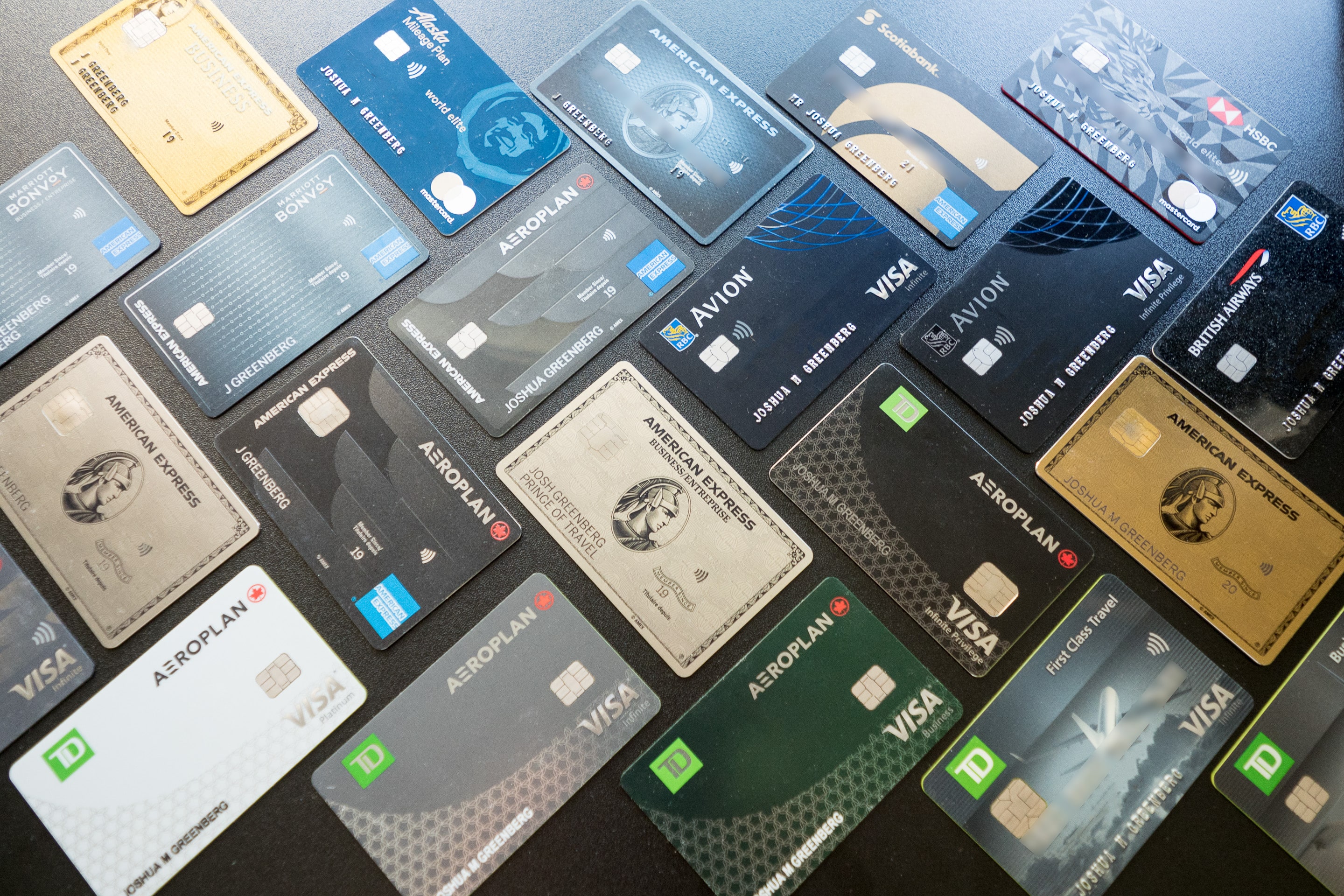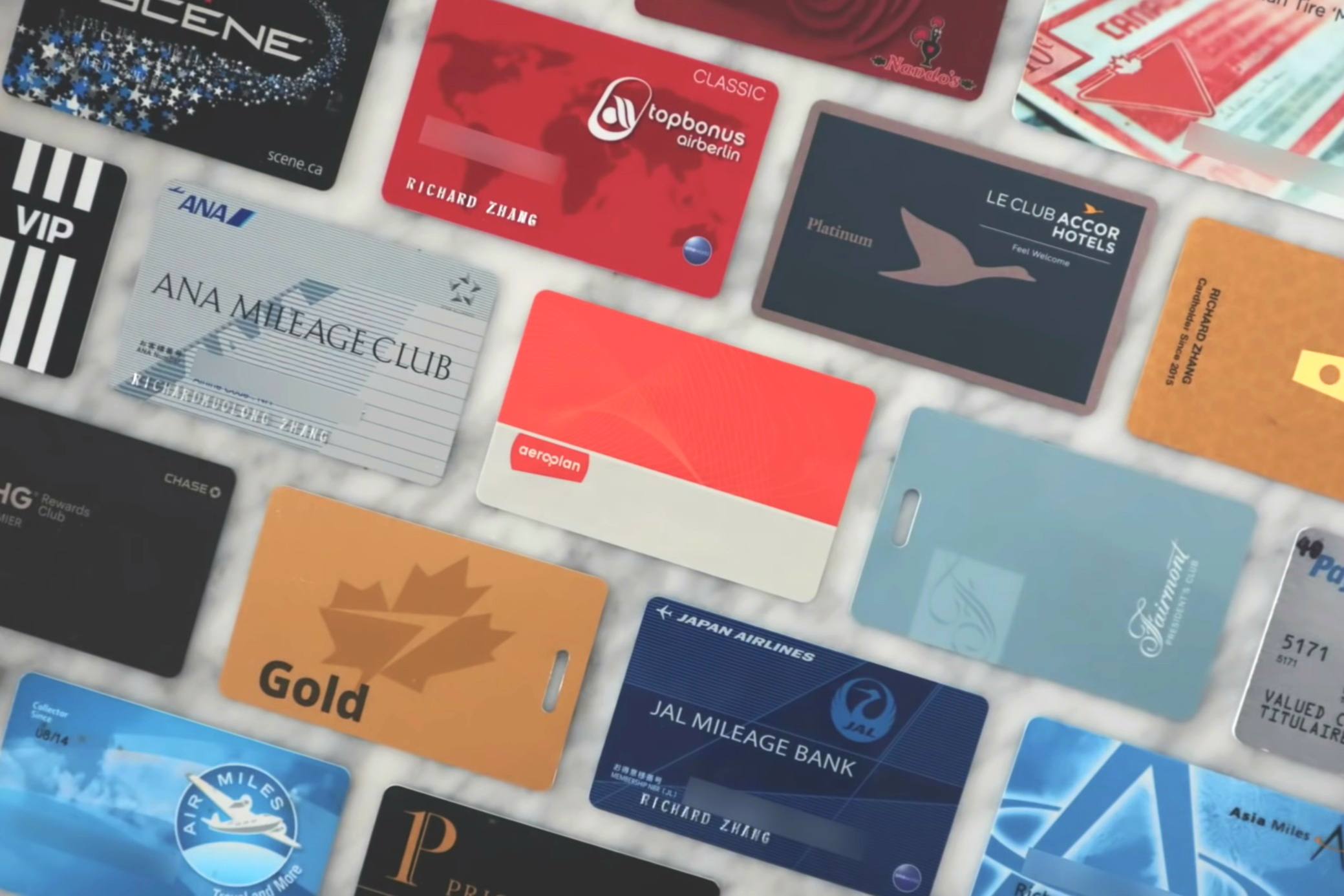Miles & Points for Beginners: Choosing the Right Credit Card

In previous parts of our Miles & Points for Beginners series, we explored why points matter, the importance of setting a goal, and the value and power of flexible points.
Now that you have a foundation of miles and points knowledge, it’s time for the most important part of the series yet. The next step in your journey is to choose the right credit card.
It’s easy to get overwhelmed at this stage, since there are literally hundreds of options at your disposal. What’s more, credit card welcome bonuses fluctuate often, and even earning rates can change.
After reading through this guide, you’ll be able to strategically approach how to choose the right credit card(s) to help meet your travel goals.
Welcome Bonuses: Earn Points Fast
Welcome bonuses will play a large role in your overall credit card strategy. With welcome bonuses, you earn a huge chunk of points after meeting the requirements that are outlined in the offer.
For example, at the time of writing, the Marriott Bonvoy American Express Card comes with a welcome bonus of 55,000 Bonvoy points upon spending $3,000 (all figures in CAD) in the first three months.
Historically, all credit cards followed a similar welcome bonus formula; however, in recent years, most banks have moved away from the simple “spend $X in three months and receive Y amount of points” for their credit card welcome bonuses.
Instead, we’re seeing the welcome bonus being broken down into multiple chunks, incentivizing you to keep your credit card open for longer, or to spend more.
Some examples of this at the time of writing are as follows:
American Express Gold Rewards Card
- Earn 10,000 MR points upon spending $4,000 in the first three months
- Earn 5,000 MR points upon spending $1,000 in each of the first twelve months
TD® Aeroplan® Visa Infinite* Card
- Earn 10,000 Aeroplan points upon first purchase†
- Earn 20,000 Aeroplan points upon spending $6,000 in the first 180 days†
- Earn 20,000 Aeroplan points as a one-time anniversary bonus upon spending $10,000 within 12 months of account opening†
American Express Aeroplan Reserve Card
- Earn 60,000 Aeroplan points upon spending $7,500 in the first three months
- Earn 25,000 Aeroplan points upon spending $2,500 in month 13
Scotiabank Gold American Express® Card
- Earn 20,000 Scene+ points upon spending $1,000 in the first three months
- Earn 20,000 Scene+ points upon spending $7,500 in the first year
As we can see, all of these cards provide additional points if you’re able to spend more money past the initial three to six months of card membership.
When picking out a credit card, the welcome bonus should be a major consideration, since it’s a one-time opportunity to take advantage of a card’s offer.
Looking at our first example, with the Marriott Bonvoy American Express Card, you receive 55,000 Marriott Bonvoy points upon spending $3,000 in the first three months.
If you want to earn Marriott Bonvoy points through regular credit card spending, you’d have to spend $27,500 on everyday purchases with the Marriott Bonvoy American Express Card to earn the same 55,000 Marriott Bonvoy points.
That said, you shouldn’t jump at the first notable welcome bonus you see. There are four rules you should follow when deciding on your next credit card:
- Choose a credit card that earns points that you need to meet your goal
- Have a plan for how to meet the welcome bonus requirement(s)
- Apply for the credit card when the welcome bonus is at or close to its all-time high
- Pay attention to the annual fee
Choose the right card for your goal
As we have already covered in this series, it’s important to have a travel goal in mind and to work backwards to create a plan for how to reach this goal.
If your goal is to fly business class, then the Marriott Bonvoy American Express Card, which earns hotel points, won’t be of much use, even if the welcome bonus is very high.
Instead, to work towards your goal of a business class flight, you’d want to choose a credit card that either earns airline points directly or a flexible points currency that can be transferred to a chosen loyalty program.
Have a plan
It’s important to pay attention to the welcome bonus requirements.
Welcome bonuses often change, so before you apply for a credit card you should make note of the expected bonus and what requirements must be met to earn it. Better yet, take a screenshot of the application page for your own records.
Next, before applying for the credit card, you should already know exactly how you plan on meeting the spending requirement.
It’s possible to earn hundreds (and in some cases thousands) of dollars worth of credit card points just through the welcome bonus. However, if you wind up spending hundreds or thousands of dollars more than you otherwise would just to chase a welcome bonus, it clearly won’t be worth it.
One of the easiest ways to work towards a minimum spending requirement is if you’re able to charge a large purchase to your card (e.g., a new washer/dryer, a cash flight, tuition).
If you don’t have any large purchases planned while you’re trying to meet a minimum spending requirement, you’ll want to sketch out your plan for meeting the spend to make sure you’ve accounted for any variables in play (e.g., your expected spending during the timeframe, where the card is/isn’t accepted for payment, your credit limit).
Additionally, keep in mind that you should pay off your credit card balance in full each month. If you don’t do this, the value of the points you’ve earned can be quickly diminished by the interest charges you incur on the debt.
Timing your application
Most credit card welcome bonuses will change a couple of times per year, and banks won’t advertise if a specific welcome bonus is low or high relative to past bonuses.
Since keeping track of every credit card’s historical welcome bonus is not something we’d expect you to do, we’ve done this work for you!
Our individual credit card pages each include a graph at the bottom which keeps track of welcome bonus changes over time to help guide your decision on when to apply for a credit card.
We also update our readers on all the important welcome bonus changes through our website, so make sure you stay up to date on the latest information, be sure to sign up for our newsletter!
If you’re strategic and you time your credit card application well, a solid welcome bonus could get you one step closer to realizing your travel goal.
Pay attention to the annual fee
For our last rule, we bring the focus to the need to be mindful of a credit card’s annual fee.
High annual fee credit cards are not always a bad thing, as they tend to come with higher welcome bonuses, but you do still need to make sure you’re getting your money’s worth.
In the same way, you should be aware that just because a credit card has a low annual fee doesn’t mean it’s a great deal.
Let’s have a look at the publicly available Canadian credit card with the highest annual fee, the American Express Platinum Card.
- Earn 70,000 MR points upon spending $10,000 in the first three months
- Plus, earn 30,000 MR points upon making a purchase in months 14–17 as a cardholder
- Also, earn 2x MR points on all dining and travel purchases
- Also, receive an annual $200 travel credit
- Also, receive an annual $200 dining credit
- Transfer MR points to Aeroplan and other frequent flyer programs for premium flights
- Unlimited airport lounge access for you and one guest at Priority Pass, Plaza Premium, Centurion, and other lounges
- Credits and rebates for daily expenses throughout the year with Amex Offers
- Bonus MR points for referring family and friends
- Annual fee: $799
This card has an annual fee of a staggering $799 per year!
However, each year you’ll receive a $200 travel credit and a $200 dining credit. Assuming you can maximize these credits, you’re left with an effective annual fee of $399. This is a little better, but it’s still fairly high.
The welcome bonus for the American Express Platinum Card is currently structured as follows:
- Earn 70,000 Membership Reward points upon spending $10,000 in the first three months
- Earn 30,000 Membership Reward points upon making a purchase in months 14–17 as a cardholder
If we just look at the first year, 70,000 Membership Reward points are worth $1,540 based on our valuation of 2.2 cents per point.
That means that even if you don’t consider the $400 in credits mentioned above, the American Express Platinum Card is still a great deal – at least for the first year.
Whether the ongoing benefits are worth it year after year is a whole other discussion (which we’ve explored at length in another article).
As you can see, despite the high annual fee, the American Express Platinum Card offers a good value return IF you can meet the minimum spending requirements to earn the welcome bonus.
Regardless of which credit card(s) you’re planning to sign up for, it’s important to always weigh the annual fee cost against the value gained through the welcome bonus, earning potential, and general perks and benefits of the card.
Earning Rates & Daily Spending
When choosing the right credit card, you also want to pay attention to the card’s earning rates.
Credit cards offer different earning rates on your spending based on the category your purchase falls within.
For example, the same credit card might earn you 3 points per dollar spent on groceries and only 1 point per dollar spent on gas.
Therefore, it’s worth taking the time to audit what you spend money on, and then look for cards that have the best earning rates in as many categories as possible.
Additionally, some cards are better than others for specific categories, and that’s why it’s best to build a small portfolio of cards to ensure you’re maximizing your return on every dollar you spend.
Let’s look at some examples of credit card earning rates on popular cards in Canada:
- Earn 5 Membership Rewards points per dollar spent on groceries and dining
- Earn 3 Membership Rewards points per dollar spent on streaming services
- Earn 2 Membership Rewards points per dollar spent on gas, public transit, and travel purchases
- Earn 1 Membership Rewards point per dollar spent on all other purchases
- Earn 3 Avion Premium points per dollar spent† on qualifying grocery, dining, food delivery, gas, rideshare, daily public transit, electric vehicle charging, streaming, digital gaming, and digital subscriptions†
- Earn 1 Avion Premium point per dollar spent† on all other qualifying purchases†
TD First Class Travel® Visa Infinite* Card
- Earn 8 TD Rewards Points† per dollar spent on travel booked through Expedia® for TD†
- Earn 6 TD Rewards Points† per dollar spent on groceries and restaurants†
- Earn 4 TD Rewards Points† per dollar spent on recurring bills and purchases†
- Earn 2 TD Rewards Points† per dollar spent on all other purchases†
CIBC Aeroplan® Visa Infinite Privilege* Card
- Earn 2 Aeroplan points per dollar spent on eligible Air Canada and Air Canada Vacations purchases†
- Earn 1.5 Aeroplan points per dollar spent on eligible groceries, gas, dining, food delivery, electric vehicle charging, and travel purchases†
- Earn 1.25 Aeroplan points per dollar spent on all other eligible purchases†
When comparing earning rates across credit cards, you need to keep in mind that not all points provide equal value or opportunity. If you aren’t familiar with a specific points currency, you can reference our points valuation guide to help you out.
Comparing credit card earning rates can be fairly nuanced, since the true value of the points you earn will depend on whether they actually have value for you and your travel goals.
That said, let’s provide a little bit of context to the rates we’ve mentioned above.
To begin, the American Express Cobalt Card often comes up as the best points-earning card in Canada, and while this is generally true, as we can see, you can actually earn more points when you fill up your gas tank with the RBC® ION+ Visa.
Continuing down the list, the TD First Class Travel® Visa Infinite* Card comes with 8 TD Rewards Points† per dollar spent on travel booked through Expedia® for TD†.
TD Rewards Points† are worth 0.5 cents per point at most, so they shouldn’t be viewed as having the same value as, say, Aeroplan points, which we value at 2.1 cents per point.
That being said, if you often book travel through Expedia, the TD First Class Travel® Visa Infinite* Card may be worth considering, since you’re looking at up to a 4% return on your spending.
Looking at the CIBC Aeroplan® Visa Infinite Privilege* Card, we see that of the four cards mentioned, it has the best earning rate for “all other purchases” at 1.25 points per dollar spent (note that the 2 TD Points per dollar spent rate in this category is only about half as valuable as this based on our valuations).
Sure, other cards might be better for groceries, gas, or travel expenses, but if you spend a lot in categories that don’t normally have elevated earning rates, you may want to consider a credit card like the CIBC Aeroplan® Visa Infinite Privilege* Card with its slightly higher base earning rate.
Ultimately, the best card(s) for you come down to how much you spend on your day-to-day expenses and in what categories.
With this in mind, the best credit card strategy is to have a couple of cards at your disposal at all times so that you can rotate through them depending on where you are making your purchase.
Double Dipping
In addition to earning points on daily spending, you can also boost your miles and points balances by double dipping.
A lot of the major loyalty programs have partnerships with retailers that allow you to earn points through specific purchases.
For example, the Aeroplan eStore is an online portal that allows you to earn Aeroplan points on your online shopping at more than 240 retailers.
In recent years, we’ve seen the eStore offer bonuses of 5x, 7x, and even 10x the Aeroplan points for shopping at popular stores like Amazon, Apple, Lululemon, and more.
The double dipping comes into play here since the Aeroplan points you earn through the eStore are on top of the points you’ll earn with your credit card.
Other notable programs with their own shopping portals include Air France KLM Flying Blue and British Airways Executive Club.
In fact, almost every airline loyalty program has their own version, and you can find each one of these by googling the program name you want (e.g., Aeroplan) followed by “shopping portal.”
Beyond online shopping portals, another way to double dip when earning points is through airline partnerships.
For example, Air Canada’s Aeroplan program has partnerships with Starbucks and Uber, and by linking your accounts, you can earn even more Aeroplan points on expenses you would have anyways.
A third opportunity to double dip on points is whenever you pay cash for a flight and use your credit card for the expense.
When you book an eligible flight, you earn airline miles for the airline you’re flying with or for a partner airline (depending on which loyalty program you choose to use).
If you then use the airline’s co-branded credit card for the initial flight purchase, you can earn even more points.
For example, an Air Canada Economy (Flex) fare from Toronto to Vancouver with Air Canada will earn you around 2,087 Aeroplan points just for the flight.
If you then use an Aeroplan credit card like the American Express Aeroplan Reserve Card to pay for your flight, you can also earn 3 Aeroplan points per dollar spent on the flight.
Conclusion
Navigating the world of miles and points and picking the right credit card can be overwhelming.
With a strategic approach focused on welcome bonuses and earning rates, you can elevate your credit card game to achieve your travel goals.
By first choosing credit cards that align with your travel goals, planning how to meet spending requirements, timing your applications for maximum bonuses, and being mindful of annual fees, you can build a robust portfolio that enhances your travel experiences.
Additionally, leveraging earning opportunities through category bonuses and double dipping with loyalty programs will further accelerate your points accumulation.
As you continue your journey into the world of miles and points, your best allies are strategic planning and an ever-growing miles and points knowledge.
Stay tuned for the next part in our Miles & Points for Beginners series.
The post Miles & Points for Beginners: Choosing the Right Credit Card appeared first on Prince of Travel by Tyler Derksen.
from Miles & Points for Beginners: Choosing the Right Credit Card
Source: https://travelblogbd237.wordpress.com/









Comments
Post a Comment